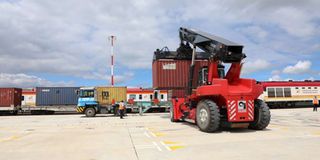Naivasha ICD sees poor activity despite compulsory usage order

What you need to know:
- Cargo volumes leaving Mombasa for Nairobi and Naivasha declined in the first six months.
- The slow uptake despite the order enforced in the entire month, now sends stakeholders back to the drawing board.
- Last week, CS Macharia said the ministry was undertaking additional investments at the Naivasha facility.
Only 14 cargo trains used the Mombasa-Naivasha standard gauge railway line in June even after the government directed that all goods destined for Uganda, Rwanda and South Sudan be cleared at the Naivasha depot.
The slow uptake despite the order enforced in the entire month, now sends stakeholders back to the drawing board on the viability of the facility other incentives such as reduced cargo tariffs to woo importers notwithstanding.
Data from the inland container depot operations also show that cargo volumes leaving Mombasa for Nairobi and Naivasha declined in the first six months of the year compared to last year despite having added the new line to Suswa.
DIRECTIVE SUSPENDED
The Kenya Ports Authority in a public notice suspended the directive after protests from transporters and logistic firms in and out of the country as the port viability faces scrutiny.
“The use of the Mombasa-Naivasha SGR cargo services remains optional. The earlier order issued jointly in August, 2019 by KPA managing director and commissioner general KRA mandating the use of the SGR remains suspended,” KPA acting managing director Rashid Salim wrote.
The order, which was meant to whip cargo owners with goods going beyond Nairobi to use the new inland container depot near Suswa, remained effective last month, making the period a key indicator of the volumes the port may handle in full operations.
The rate, representing a train every two days during the month and carrying 2,000 tonnes on average even under order for compulsory use, presents a major challenge for the new SGR line launched late last year, and billed as a game changer in the Northern corridor cargo transport.
ADDITIONAL INVESTMENTS
Transport and infrastructure Cabinet secretary last week said the ministry was undertaking additional investments at the Naivasha facility, including an expanded marshalling yard, and works are expected to be completed by July 15.
SGR cargo trains and tonnage from Mombasa recorded a 2.3 percent drop in the first six months of 2020 compared to 2019 when there was only the first phase of the line between Nairobi and Mombasa. The new line comes with additional operation and maintenance bill despite the low utilisation.
Data from Nairobi’s Inland Container Depot also show that there were 22 fewer trains during the period compared to last year despite an additional 14 trains run between Nairobi-Suswa in the first half of 2020.
A drop in cargo volumes which is the main revenue channel for the line built by loans from China now adds to the financial burden of operating the railway line whose passenger services were halted from April 6 due to the Covid-19 pandemic.
Kenya requires additional cash from the railway business to ease the taxpayers’ burden of paying the Chinese SGR operator and service the loans which began falling due this year after the end of the five-year grace period granted in May 2014.





